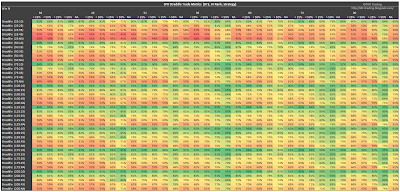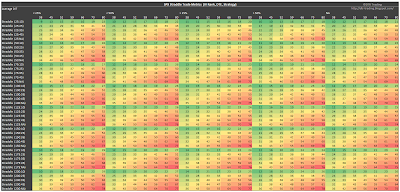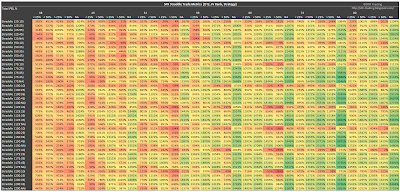This post reviews the backtest results for 4160 options straddles sold on the RUT at 73 days-to-expiration (DTE). Eight different loss approaches were tested on these straddles. On top of these eight loss approaches, tests were conducted with no profit taking, and profit taking at 10%, 25%, 35%, and 45% of the credit received. In the next article, the performance of trades initiated at 80 DTE will be explored. You can find the prior RUT straddle summary posts at the links below:
- RUT Straddle - 38 DTE - Results Summary
- RUT Straddle - 45 DTE - Results Summary
- RUT Straddle - 52 DTE - Results Summary
- RUT Straddle - 59 DTE - Results Summary
- RUT Straddle - 66 DTE - Results Summary
The results for these backtests are summarized in six heat map tables. In these tables, each row corresponds to a different loss exit percentage. For example, the first row (25) corresponds to the strategy variations where losses were taken at 25% of the credit received. These rows have values from 25 to 200. The columns are a little more complicated, and are grouped first by IV rank (IVR) level, and then by profit exit percentage. You can see that each IVR percentage level contains five columns (10, 25, 35, 45, and NA)...with each column representing a profit taking percentage. For example, the first column lists all of the strategy variations where the IVR was less than 25% and profits were taken at 10% of the credit received.
The first table shows the average normalized P&L per day by IVR, profit taking percentage, and loss taking percentage. We see the familiar pattern of the IVR > 50% level outperforming the other IVR levels in terms of P&L per day. The highest daily returns were concentrated in the 45% profit taking level with IVR > 50%. These were the highest P&L per day readings that we have seen in the RUT straddle backtests, with many readings above 1%.
 |
| (click to enlarge) |
The second table shows the average P&L per trade by IVR, profit taking percentage, and loss taking percentage. The IVR > 50% level again had the highest P&L per trade readings, with the 45% profit taking level having the greatest strength. This 45% profit taking level had many readings of 64% returns (based on initial PM requirement). These were the highest P&L per trade readings that we have seen in the RUT straddle backtests.
 |
| (click to enlarge) |
The third table shows the win percent / win rate by IVR, profit taking percentage, and loss taking percentage. The lower the profit taking percentage, the higher the win rate for a given IVR grouping. The highest win rates occur with profit taking at 10%. This 10% level had a number of win rates at 100% for the IVR > 50% level. There were also a number of win rates of 94%, 95%, and 96%.
 |
| (click to enlarge) |
In the fourth table, we see Sortino Ratios by IVR, profit taking percentage, and loss taking percentage. There were a few cells in the table that displayed as "######" (undefined) because of the 100% win rates associated with these strategy variations. There were some very large Sortino readings in the IVR > 50% group...some of the biggest we've seen for straddles, with many greater than 1. The largest Sortinos were concentrated in the IVR > 50% group, with profit taking at 45% and loss taking between 75% and 200%.
 |
| (click to enlarge) |
The fifth table shows profit factor by IVR, profit taking percentage, and loss taking percentage. The region of greatest strength was the IVR > 50% group. The largest value was 35.8 and occurred in the IVR > 50% group, with profit taking at 45% and loss taking between 75% and 200%.
 |
| (click to enlarge) |
The last table shows the average days-in-trade (DIT) by IVR, profit taking percentage, and loss taking percentage. Quicker profit taking, translates into shorter time in the trade.
 |
| (click to enlarge) |
Which variation of the 73 DTE RUT straddle is best? If I was going to sell a 73 DTE ATM RUT straddle every month, I would go with the non-IVR filtered variation, taking profits at 25%, with a loss threshold of 50%. This would put the lower bounds of my gains at 50% of my losses (25/50). The win rate should be approximately 86%, profit factor at 3.9, and an average P&L per trade of 25%.
Based on all of my SPX and RUT straddle backteests, an IVR of greater than 50% occurs during only about 20% of all possible monthly trade entries. When this occurs at a 73 DTE trade entry, I would increase my trade size, take profits closer to 35%, and move my loss taking level to 75%. This would also cause my trade duration to move from about 41 DIT to 50 DIT.
You can find links to all of my RUT straddle articles, and RUT straddle tweets on the RUT Straddle Summary Page. In the next post, we will look at the automated backtest results for the short straddle on the RUT at 80 DTE.
Follow my blog by email, RSS feed or Twitter (@DTRTrading). All options are available on the top of the right hand navigation column under the headings "Subscribe To RSS Feed", "Follow By Email", and "Twitter".













































